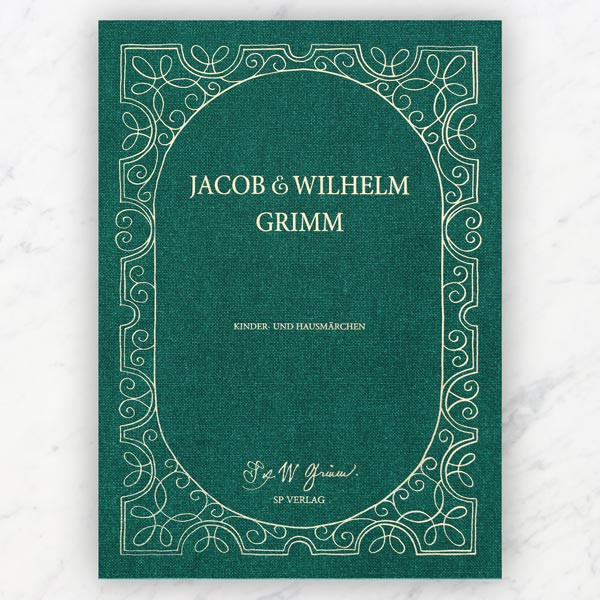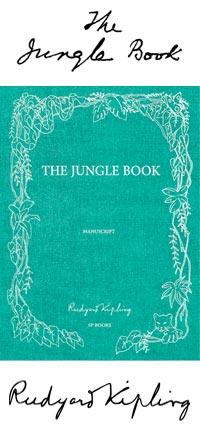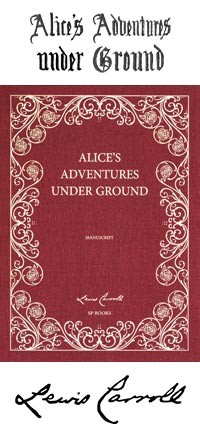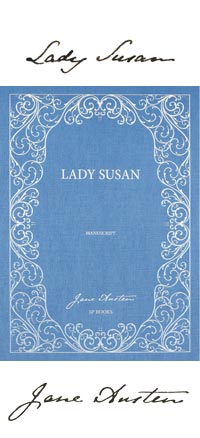The Fairy Tales by Jacob & Wilhelm Grimm
Bottle green edition,
numbered from 1 to 1,000
The essay is in English
The manuscript of Grimm's Fairy Tales
Sleeping Beauty, Snow White and The Frog King... Be immersed in the magical world of Grimm’s Fairy Tales.
Barely two hundred years separate us from Grimm’s Fairy Tales, which were collected and transcribed by the brothers Jacob and Wilhelm Grimm in 1810, and published for the first time in 1812. These seemingly familiar tales lie both close and out of reach – they remind us of being frightened and amazed by incredible stories told before childhood bedtimes, yet are rich in subtexts and symbols intended for adult audiences.
The first manuscript of Grimm’s Fairy Tales is a surviving treasure intertwining many stories, and stands apart from the successive versions which altered the tales to adapt them to a young audience. Almost fifty years separate this document from the final version edited by the Brothers Grimm.
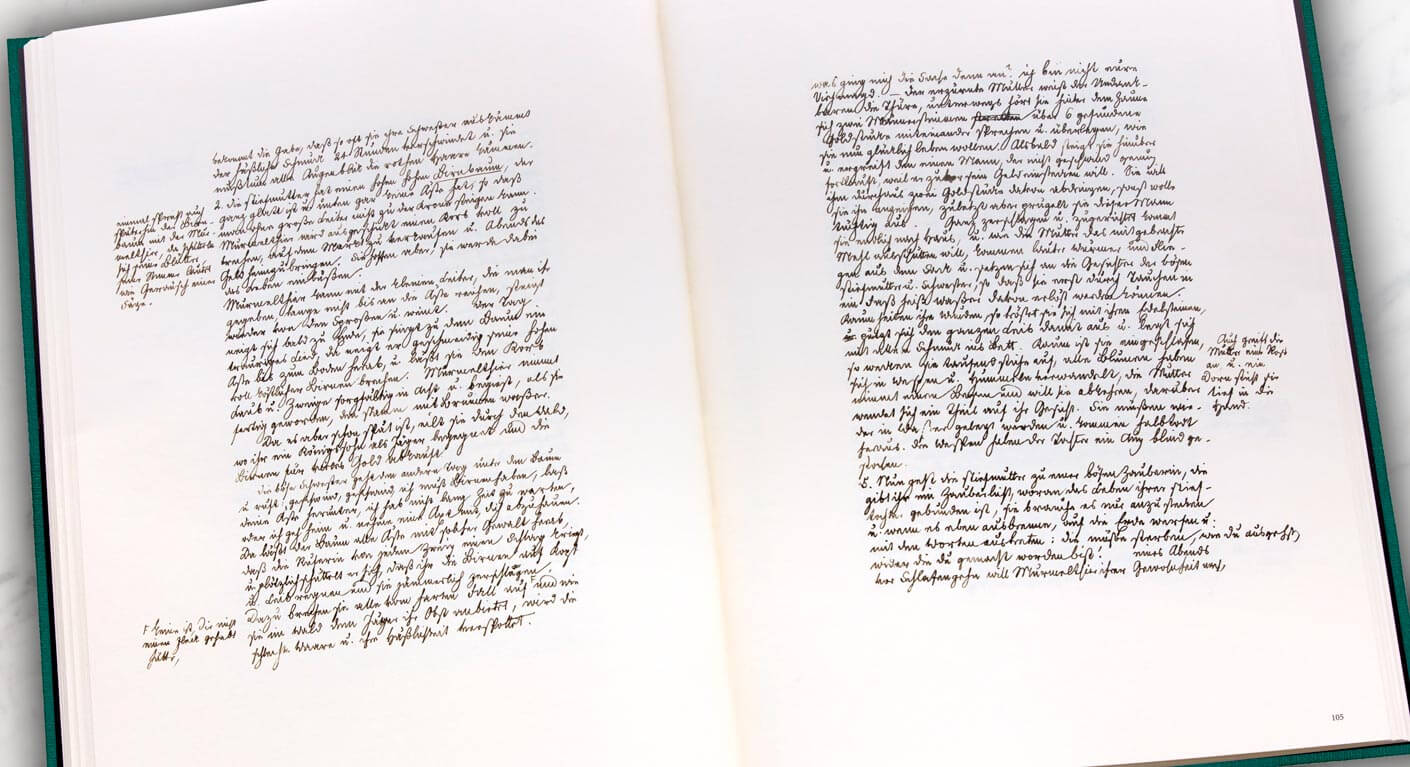
From a private project to a global bestseller
Endowed with a natural gift for studying, Jacob and Wilhelm Grimm enrolled at the University of Marburg in 1802. One of their professors, Savigny, who would come to have a great impact on their lives, encouraged them to study the history of law and German history, language and literature. In 1808, Jacob was appointed as private librarian in Kassel to Jérôme Bonaparte, who had been installed on the throne by his brother. Through Savigny, the brothers came into contact with Clemens Brentano and Achim von Arnim, two famous writers who were searching for texts to complete their collection Das Knaben Wunderhorn (The Boy's Magic Horn).
Three years later on 25 October 1810, the Grimms sent them the poems and tales they had collected, mostly from local descendants of Huguenot families from the Hesse region in central Germany, including Dorothea Viehmann – making up the contents of this very manuscript. It is the oldest manuscript version of the Kinder- und Hausmärchen (Children's and Household Tales), as the Grimm brothers resolutely destroyed their other drafts, likely in order to prevent comparisons with later versions. As the Brentano-Arnim project failed to materialise, the Grimm brothers continued the work independently. The first edition was published in 1812, thanks to a working copy (which was also destroyed).
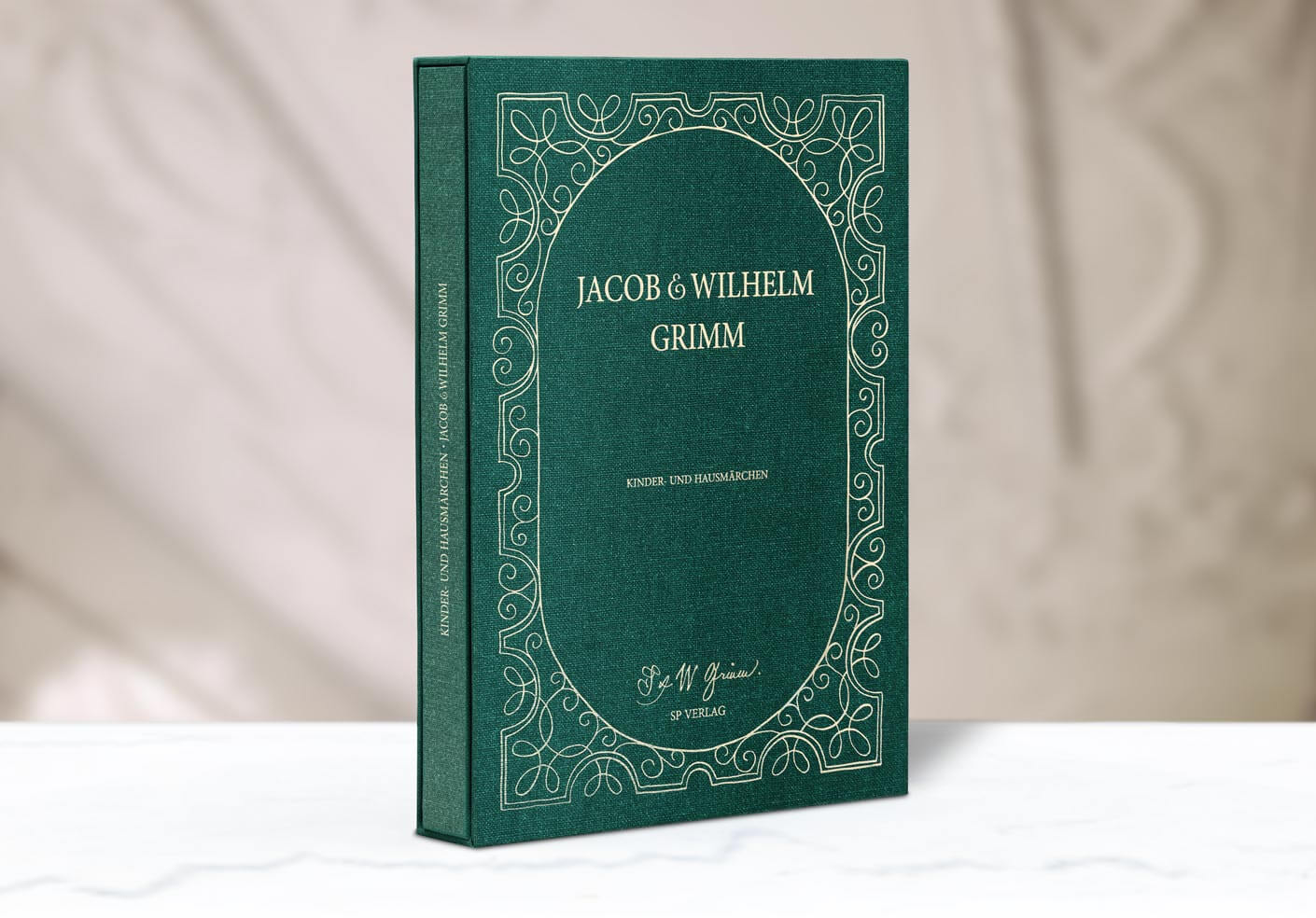
For his part, Clemens Bretano held onto the manuscript reproduced here without using it – making it another original version that wasn’t erased, different from the first. This document was part of the archives left at his death in 1842 to the abbot Ephrem Van der Meulen, who bequeathed it in 1884 to the Trappist convent of Oelenberg in Alsace.
The Grimm brothers’ success was not immediate – they had a lengthy literary and narrative road to travel. It was mainly the undertaking of Wilhelm, who, ‘throughout the course of multiple reprintings, intensifies the familiar expressions and versified refrains, also resorting more and more to the device of tripling episodes and phrases. Grimm's tales adopt an easy syntax, with short clauses juxtaposed or linked by a simple conjunction (...). In this, the Grimms take up the thread of La Fontaine, Perrault and Galland’s achievements in Louis XIV’s France, though their model of simplicity and nature is geared towards the middle-class society and writers of their own time.’ (see Jean-Paul Sermain’s preface).
Wilhelm and Jacob Grimm – the now legendary linguists, philologists and authors – finished working on their collection in 1857.
Universally popular fairy tales
Amongst a rich list of 45 tales and a legend, 25 tales are written in Jacob’s hand, 14 in Wilhem’s hand and seven others attributed to four other authors. Readers will be enchanted by the familiar characters and universes: those Sleeping Beauty, Snow White, the Frog King and even Rumpelstiltskin… They will also be able to decipher, throughout the manuscript, inscriptions in French directly linking the work of the Brothers Grimm to that of Charles Perrault (Hop-o'-My-Thumb, The Fairies), more than a century earlier.
An illustrated facsimile with 30 drawings by Arthur Rackham
In this edition, the handwritten lines of the Brothers Grimm are interwoven with the iconic illustrations of Arthur Rackham.
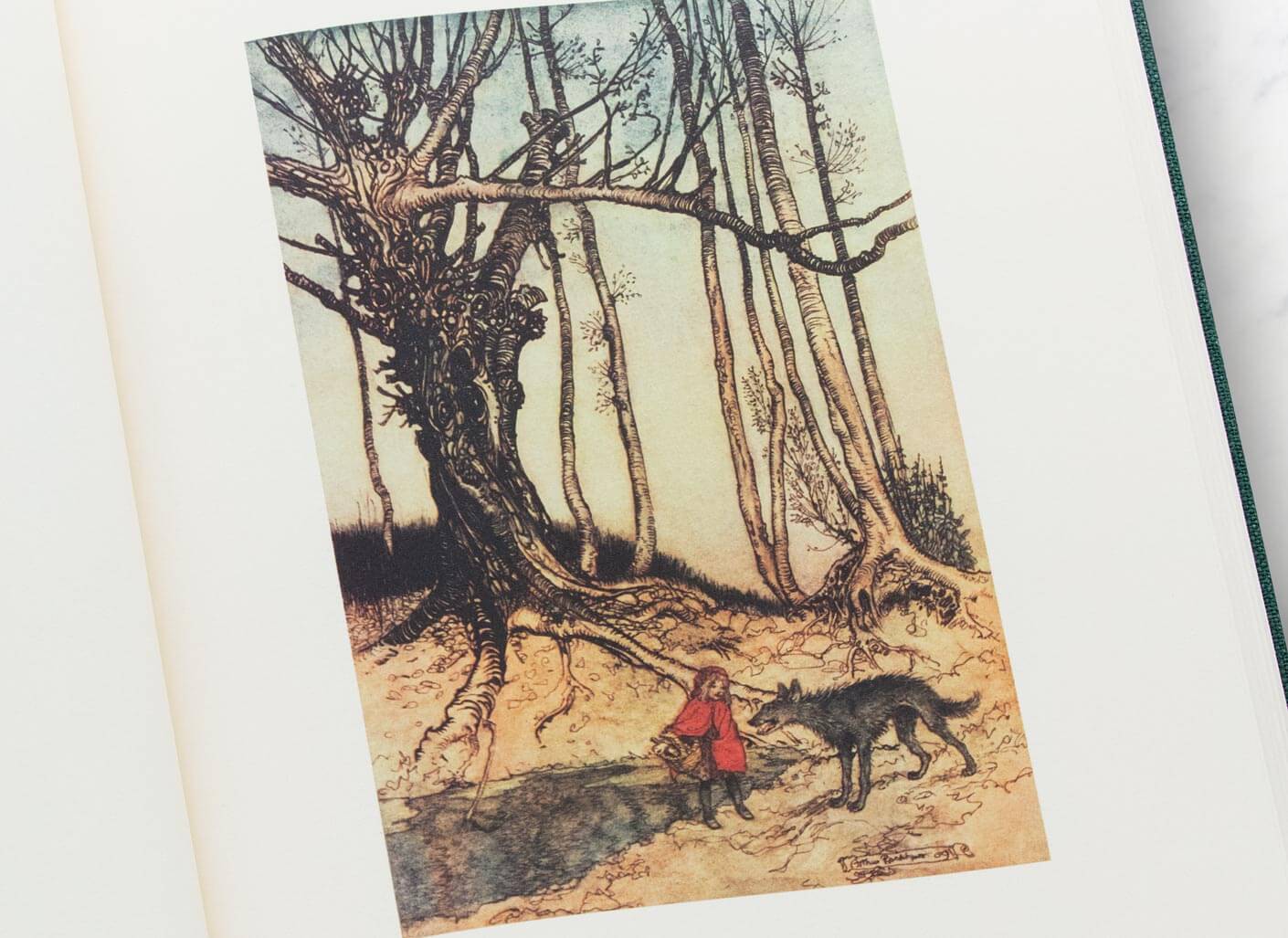
Arthur Rackham (1867-1939) is one of the pioneers of ‘fairy painting’, a pictorial genre depicting fairies or scenes from fairy tales often associated with the Victorian era. The British artist is famous for his illustrations for the tales of Andersen and Perrault, and for Peter Pan in Kensington Gardens. Major exhibitions have been devoted to him all over the world.
A preface by Professor Jean-Paul Sermain
‘The majority of these tales contain wonders and enchantments, and while this collection represents only about a third of the total in the definitive edition (1857), it is popular with the public. This first manuscript demonstrates that the Grimm brothers are aware of the broader tradition of Märchen, since they bring in elements of French fairy tales, notable in the stories with animal heroes, or those centred on plants or objects – alternately parable or fable, comic or serious, but always filled with adventure.’
Jean-Paul Sermain is a professor at the Sorbonne Nouvelle University - Paris 3. An 18th century specialist, his research focuses on 18th century literature, the poetics of the novel and fairy tales. He also works on the oeuvres of Marivaux, Prévost and Diderot. He is the author of reference works including: Le conte de fées du classicisme aux lumières (Paris, Desjonquères, 2005), and Les Mille et une nuits entre Orient et Occident (Paris, Desjonquères, 2009).
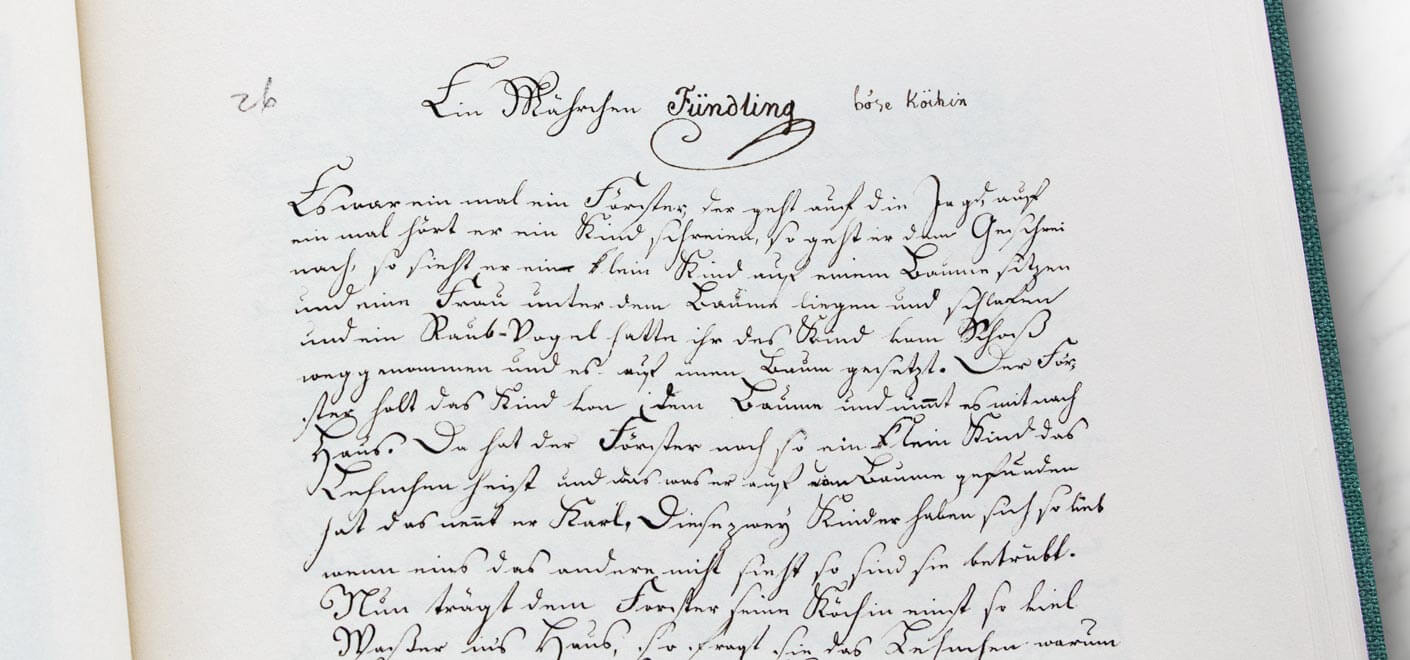
One of the most valuable manuscripts at the Fondation Martin Bodmer
The manuscript of Grimm’s Fairy Tales is preserved at the Fondation Martin Bodmer. It was acquired in 1953 from Mary A. Benjamin, an American specialist of such renown that she was sometimes known simply as ‘The Autograph Lady’.
Since its creation in 1971, Fondation Martin Bodmer has been a major draw for bibliophiles and lovers of literature. More than 150,000 items of papyrus, incunabula, manuscripts and rare editions are found in its collections, which bring together texts from Mesopotamia and Egypt dating from 3000 BC alongside contemporary works from the 20th century. The foundation’s mission is to capture the essence of human thought throughout the history of civilisation, and its transmission throughout the ages to all parts of the world.
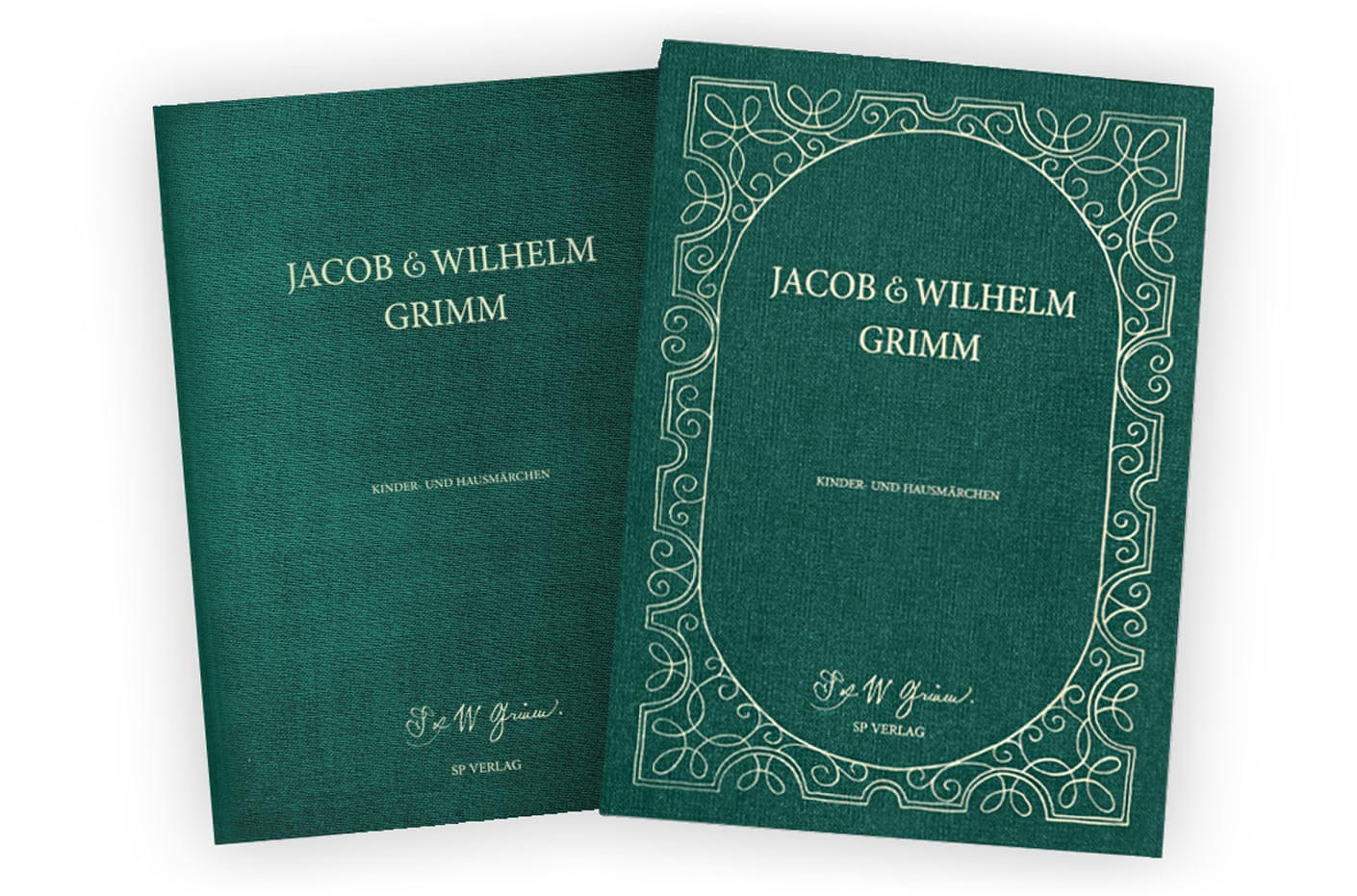
Born in 1899, Martin Bodmer began to collect ‘world literature’ from the age of 15. He took the visionary recommendations of Goethe as a guide for composing his collection, in favour of the model of ‘enlightened’, tolerant and enriched Weltliteratur libraries, based on mutual exchange, advanced knowledge of each country’s literature, and understanding of the particularities of other nation’s ways of thinking, in order to help curb the patriotic aggrandisement that appealed to war-hungry extremism. Also a reader of contemporary literature, he was co-founder of a literary prize and review, amongst other things.
The introduction, preface and note on the Martin Bodmer Foundation are presented in French, German and English. With thanks to: Nicolas Ducimetière et Jacques Berchtold (respectively vice-director and director of Fondation Martin Bodmer) ; Philippe Mellot ; Marc Meier-Maletz ; Jean-Paul Sermain.
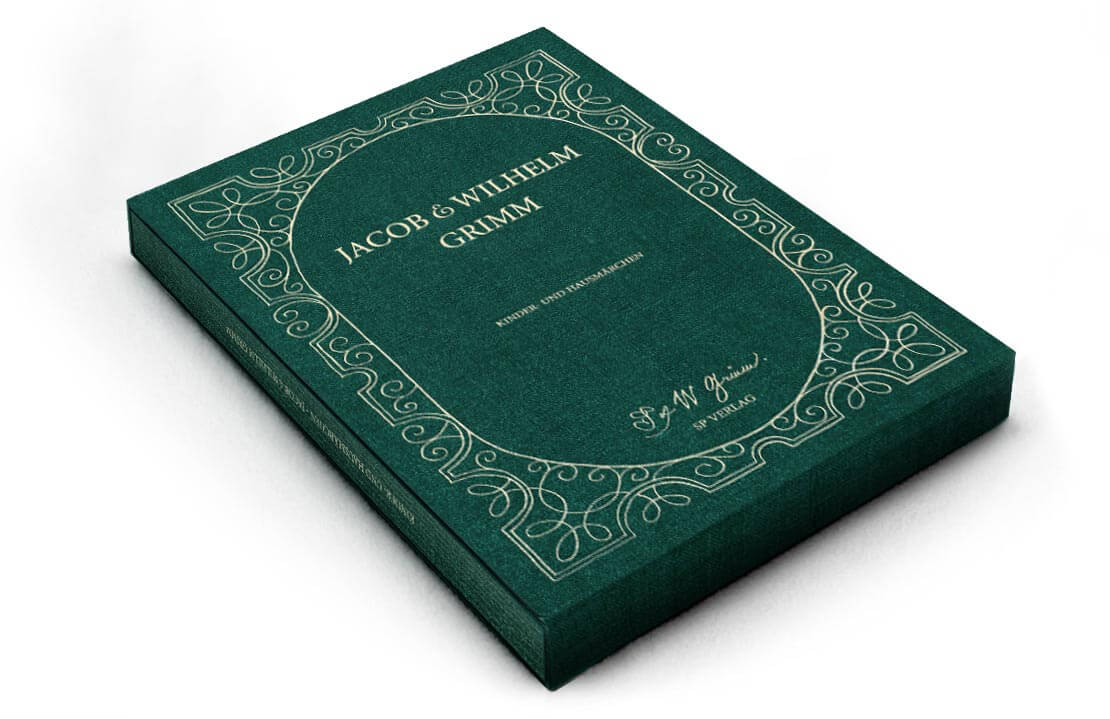
Deluxe edition
Numbered from 1 to 1,000, this Bottle green edition is presented in a large format handmade slipcase.
Printed with vegetal ink on eco-friendly paper, each book is bound and sewn using only the finest materials.
Mrs Dalloway: Thanks to a new reproduction of the only full draft of Mrs. Dalloway, handwritten in three notebooks and initially titled “The Hours,” we now know that the story she completed — about a day in the life of a London housewife planning a dinner party — was a far cry from the one she’d set out to write (...)
The Grapes of Wrath: The handwritten manuscript of John Steinbeck’s masterpiece The Grapes of Wrath, complete with the swearwords excised from the published novel and revealing the urgency with which the author wrote, is to be published for the first time. There are scarcely any crossings-out or rewrites in the manuscript, although the original shows how publisher Viking Press edited out Steinbeck’s dozen uses of the word “fuck”, in an attempt to make the novel less controversial. (...)
Jane Eyre: This is a book for passionate people who are willing to discover Jane Eyre and Charlotte Brontë's work in a new way. Brontë's prose is clear, with only occasional modifications. She sometimes strikes out words, proposes others, circles a sentence she doesn't like and replaces it with another carefully crafted option. (...)
The Jungle Book: Some 173 sheets bearing Kipling’s elegant handwriting, and about a dozen drawings in black ink, offer insights into his creative process. The drawings were not published because they are unfinished, essentially works in progress. (...)
The Lost World: SP Books has published a new edition of The Lost World, Conan Doyle’s 1912 landmark adventure story. It reproduces Conan Doyle’s original manuscript for the first time, and includes a foreword by Jon Lellenberg: "It was very exciting to see, page by page, the creation of Conan Doyle’s story. To see the mind of the man as he wrote it". Among Conan Doyle’s archive, Lellenberg made an extraordinary discovery – a stash of photographs of the writer and his friends dressed as characters from the novel, with Conan Doyle taking the part of its combustible hero, Professor Challenger. (...)
Frankenstein: There is understandably a burst of activity surrounding the book’s 200th anniversary. The original, 1818 edition has been reissued, as paperback by Penguin Classics. There’s a beautifully illustrated hardcover, “The New Annotated Frankenstein” (Liveright) and a spectacular limited edition luxury facsimile by SP Books of the original manuscript in Shelley's own handwriting based on her notebooks. (...)
The Great Gatsby: But what if you require a big sumptuous volume to place under the tree? You won’t find anything more breathtaking than SP Books ’s facsimile of F. Scott Fitzgerald’s handwritten manuscript of The Great Gatsby, showing the deletions, emendations and reworked passages that eventually produced an American masterpiece (...)
Oliver Twist: In the first ever facsimile edition of the manuscript SP Books celebrates this iconic tale, revealing largely unseen edits that shed new light on the narrative of the story and on Dickens’s personality. Heavy lines blocking out text are intermixed with painterly arabesque annotations, while some characters' names are changed, including Oliver’s aunt Rose who was originally called Emily. The manuscript also provides insight into how Dickens censored his text, evident in the repeated attempts to curb his tendency towards over-emphasis and the use of violent language, particularly in moderating Bill Sikes’s brutality to Nancy. (...)
Peter Pan: It is the manuscript of the latter, one of the jewels of the Berg Collection in the New York Public Library, which is reproduced here for the first time. Peter’s adventures in Neverland, described in Barrie’s small neat handwriting, are brought to life by the evocative color plates with which the artist Gwynedd Hudson decorated one of the last editions to be published in Barrie’s lifetime. (...)









